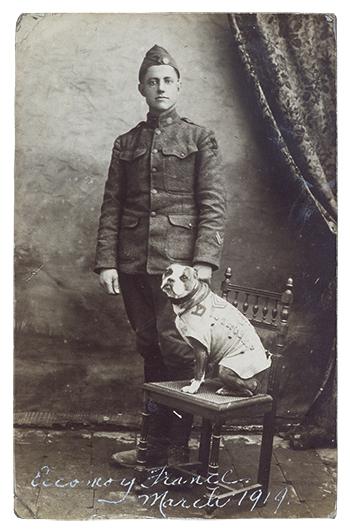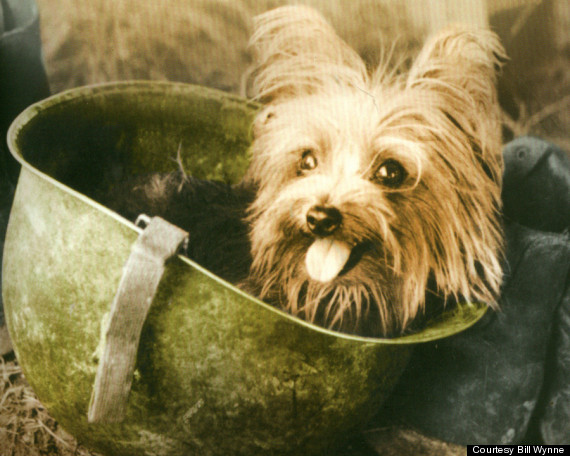
[ Back to Contemporary ] -> [ Back to Storm Dog ]
Dogs, dogs, dogs
Storm Dog
“Because of the dog’s joyfulness, our own is increased. It is no small gift.” - Mary Oliver
Military Working Dogs (MWDs)
Dogs have served faithfully alongside soldiers since ancient times. Here in America, Benjamin Franklin (the source of so many good ideas!) was the first to suggest our soldiers use them as scouts and messengers. But it was not until March 13th, 1942, that the American military officially created its K-9 Corps. March 13th, by the way, is the annual National K9 Veterans Day!
Since then, MWDs have saved thousands of lives by serving as sentries, recognizing and charging approaching combatants, plunging into enemy enclaves, and sniffing out suicide bombers, weapons caches, or IEDs, the “improvised exploding devices” that have killed and injured so many American soldiers in recent war zones like Afghanistan and Iraq.
These days, the U.S. Military has about 2,500 working dogs serving here and abroad. New K-9s are trained at Lackland Air Force Base, Texas, in an intense three-month program that determines which specialty suits them best: patrol, detection, or tracking. From there, they go on for further training with chosen handlers. The program produces about 270 dogs a year. But only half who enter that initial training will graduate, proving they have the life-or-death-necessary personality traits, endurance, devotion to duty, and responsiveness to human partners. It is a high bar for any dog (or human for that matter) to reach. Being too playful, for instance, might disqualify a dog, or wilting in one hundred-degree-plus heat, or getting too agitated at the sound of gunfire.
Most MWDs are German Shepherds or Belgian Malinois, but sporting dogs like Labradors are particularly gifted in search-and-rescue missions or tracking someone building and planting IEDs. In addition to guarding bases and sweeping vehicles entering a compound, MWDs go out on patrol, where they and their handlers search for hidden, buried explosives by walking at the head of an infantry unit, making themselves easy targets for enemy snipers. High winds and heat all dilute or confuse scents. Even then, these amazing dogs remain up to 100,000 times more alert to smells than humans.
Handlers recount hundreds of incidents of their canine partners saving both their lives and entire platoons. Some working dogs have even been awarded medals for their valor, including one named Remco, who received a Silver Star for charging an insurgent’s hideout in Afghanistan. Such bravery is the stuff of military legend, as is MWDs’ devotion to those they love. There are many a heart-wrenching story of dogs shielding their handlers from gunfire or refusing to leave their side when their human partners are injured during a battle.
Tragically, for decades—trained to attack potential enemy assailants, to react quickly to perceived threat, and often suffering their own PTSD—these heroic dogs were deemed unable to transition to civilian life and euthanized after their service.
During the Vietnam War, for instance, more than 4,000 dogs served and were so important to safeguarding soldiers—credited with saving more than 10,000 Americans— that the Viet Cong placed $20,000 bounties on them. However, only around 200 made it back home to US soil. They were either left behind in country with allies or put to sleep.
Thankfully, this changed in 2000, when the United States military—under pressure from former K9 handlers—shifted their treatment of MWDs, coming to view them as soldiers as opposed to “equipment.” The Promotion of Adoption of Military Working Dogs Regulation, also known as Robby’s Law, was passed and signed by President Clinton. It stipulates MWDs “fit for adoption” be made available to previous handlers, law enforcement, or qualifying families.
More recently, the 2016 National Defense Authorization Act granted a guaranteed ticket home for retiring MWDs and that their handlers are given priority in adopting them. Before, the adopters would have to cover the enormous expense of getting the dogs home. MWDs whose temperaments or PTSD make them less suitable for civilian homes go back to Lackland Air Force Base in San Antonio. There, they are reassigned to TSA or other law enforcement agencies with handlers who know how to work with and love them.
If you want to see a moving film about one real-life female handler and her dog, Rex, and her fight to adopt him watch Megan Leavey. The Official trailer: https://www.youtube.com/watch?v=IGGcFbW__XI.
Here is an interview with the real-life Megan Leavey: https://www.youtube.com/watch?v=KmKtAswq9Hs
Powerful books
War Dogs (YA Edition) by Rebecca Frankel
No Better Friend: Young Readers Edition: A Man, a Dog, and Their Incredible True Story of Friendship and Survival in World War II by Robert Weintraub
Articles about Military Working Dogs (MWDs):
https://www.texasmonthly.com/articles/dogs-of-war/
https://www.avma.org/News/JAVMANews/Pages/160601c.aspx
https://www.nationalgeographic.com/magazine/2014/06/dogs-war-soldiers-military-afghanistan/#close
https://www.37trw.af.mil/Units/37th-Training-Group/341st-Training-Squadron/
https://www.jbsa.mil/News/News/Article/1435911/mwd-hospital-keeps-canine-warriors-fit-for-duty/
https://www.military.com/undertheradar/2015/02/the-9-biggest-myths-about-military-working-dogs
Article about adopting MWDs:
FAMOUS MWDs:
Sergeant Stubby, WWI

Chips, WWII

Smoky, “Yorkie Doodle Dandy,” WWII

https://www.huffpost.com/entry/smoky-the-yorkshire-terrier_n_4110586
Cairo, the dog who helped find Osama Bin Laden

https://www.nytimes.com/2011/05/05/science/05dog.html
Canine Companions for Veterans
Many combat veterans, like Sergeant Josie in Storm Dog, return home suffering symptoms of PTSD (Post Traumatic Stress Disorder)—including nightmares, flashbacks, heightened alert responses, sensitivity to loud, sudden noises or crowds, or even angry outbursts. Many have suffered physical injuries and TBI (Traumatic Brain Injury). Dogs can help them cope. Specially trained to quiet symptoms of war trauma disabilities in soldiers, service canines have proven to be potent, life-changing therapy and companionship for our wounded warriors. Doing things like waking a veteran during a nightmare or licking their hand in an overwhelming crowd of people has substantially lowered PTSD symptoms. Caring for an animal and a dog reciprocating that love also lowers rates of depression and veterans withdrawing from society.
If you know a veteran who might benefit from this healing bond with a trained dog, or if you would like to support the organizations working with veterans and K9s, please see the links below:
https://www.consumersadvocate.org/features/k9s-for-warriors
https://www.k9sforwarriors.org/
https://k-9caringangels.org/programs
https://www.cci.org/assistance-dogs/Our-Dogs/veterans-initiative.html
Adopting rescued dogs:
All my dogs have been rescues and I can say from a lifetime of experience that the love these dogs feel for their person is deep and unwavering. Typically, they’ve known hard times and it is incredibly rewarding as a dog-lover to watch them bloom, come to trust again, and to play without fear. BUT, please, these animals are not to be adopted lightly! They may come to you inculcated to be wary, or unaccustomed to affection, or truly traumatized by neglect or abuse—so they need and deserve careful nurturing and patience, patience, patience. Or, they might be a breed with special needs (LOTS of running room, for instance) or have big personalities and individual quirks that have resulted in their bouncing from home to home. If you are willing to give a lot of love and attention, I promise these dogs will truly be your BFF.
Start your search with your local humane society. Or there are also rescue organizations particular to certain breeds, with foster homes and volunteers who really know and love that kind of dog and can help you decide whether you are a good match.
https://www.humanesociety.org/resources/adopting-animal-shelter-or-rescue-group
https://www.aspca.org/adopt-pet/adoptable-dogs-your-local-shelter
https://nymag.com/strategist/2019/05/everything-you-need-to-know-about-adopting-a-rescue-dog.html
DOG DANCING or “CANINE FREESTYLE”
Musical canine freestyle began in Canada and Europe in the late 1980s and is now an international competitive sport. Combining obedience training, heelwork, jumping/spinning tricks, costuming, and choreography, “dog-dancing” also highlights the musical sensibilities, partnership, and symbiosis between a trainer and their dog. Requiring concentrated work, of course, dog-dancing seems such fun to do, and certainly is a total delight to watch! Find out more:
https://www.akc.org/expert-advice/lifestyle/welcome-to-the-world-of-musical-freestyle-dog-dancing/
https://www.worldcaninefreestyle.org/
https://www.whole-dog-journal.com/training/canine-musical-freestyle/
Video tutorial: https://www.youtube.com/watch?v=GZ-ZKpk6RQk
Some of my favorite dog-dancing routines and winners:
https://www.youtube.com/watch?v=ARR5DoLXa7w
https://www.youtube.com/watch?v=J5vwAox7Y4c&feature=emb_logo
https://www.youtube.com/watch?v=pCtMpyHaDpg
https://www.youtube.com/watch?v=X10S_CDB4s4
https://www.youtube.com/watch?v=e8Ip852UvOY
https://www.youtube.com/watch?v=41TxtpBK2ZY
https://www.youtube.com/watch?v=NskEb37pFhM
https://www.youtube.com/watch?time_continue=7&v=X-EZY1JDR2g&feature=emb_logo
And finally, here are Carolyn and Rookie, the Youtube performance that introduced me to dog-dancing:
https://www.youtube.com/watch?time_continue=2&v=HqbVbPvlDoM
https://nationalpurebreddogday.com/carolyn-scott-and-rookie/
